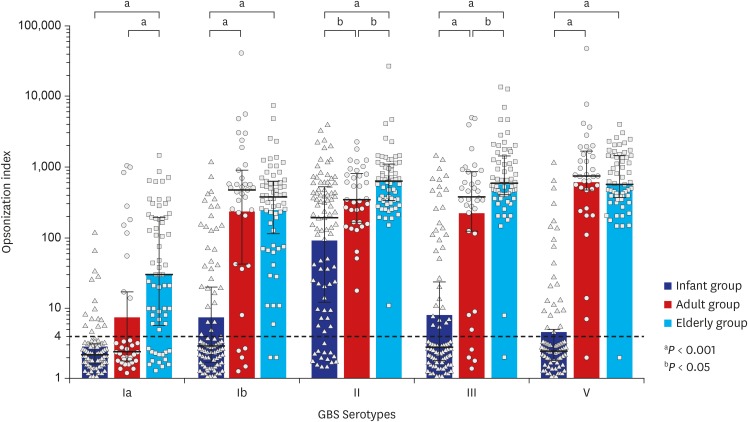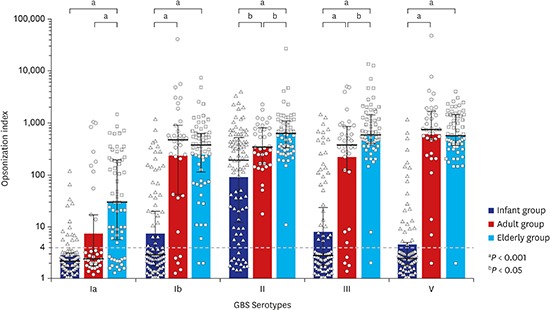1. Le Doare K, Heath PT. An overview of global GBS epidemiology. Vaccine. 2013; 31(4):D7–12. PMID:
23973349.
2. Edward MS, Baker CJ. Streptococcus agalactiae (group B streptococcus). In : Bennett JE, Dolin R, Blaser MJ, editors. Mandell, Douglas, and Bennett's Principles and Practice of Infectious Diseases. 8th ed. Philadelphia, PA: Elsevier;2015. p. 2340–2348.
3. Edmond KM, Kortsalioudaki C, Scott S, Schrag SJ, Zaidi AK, Cousens S, et al. Group B streptococcal disease in infants aged younger than 3 months: systematic review and meta-analysis. Lancet. 2012; 379(9815):547–556. PMID:
22226047.
4. Gray KJ, Bennett SL, French N, Phiri AJ, Graham SM. Invasive group B streptococcal infection in infants, Malawi. Emerg Infect Dis. 2007; 13(2):223–229. PMID:
17479883.
5. Madhi SA, Radebe K, Crewe-Brown H, Frasch CE, Arakere G, Mokhachane M, et al. High burden of invasive
Streptococcus agalactiae disease in South African infants. Ann Trop Paediatr. 2003; 23(1):15–23. PMID:
12648320.
6. Farley MM, Harvey RC, Stull T, Smith JD, Schuchat A, Wenger JD, et al. A population-based assessment of invasive disease due to group B streptococcus in nonpregnant adults. N Engl J Med. 1993; 328(25):1807–1811. PMID:
8502269.
7. Farley MM, Strasbaugh LJ. Group B streptococcal disease in nonpregnant adults. Clin Infect Dis. 2001; 33(4):556–561. PMID:
11462195.
8. Skoff TH, Farley MM, Petit S, Craig AS, Schaffner W, Gershman K, et al. Increasing burden of invasive group B streptococcal disease in nonpregnant adults, 1990–2007. Clin Infect Dis. 2009; 49(1):85–92. PMID:
19480572.
9. Baker CJ, Rench MA, McInnes P. Immunization of pregnant women with group B streptococcal type III capsular polysaccharide-tetanus toxoid conjugate vaccine. Vaccine. 2003; 21(24):3468–3472. PMID:
12850362.
10. DEVANI final report summary: DEVANI (Design of a vaccine to immunize neonates against GBS infections through a durable maternal immune response). Updated 2013. Accessed December 28, 2017.
http://cordis.europa.eu/result/rcn/55820_en.html.
11. Kim HW, Lee JH, Cho HK, Lee H, Seo HS, Lee S, et al. Opsonophagocytic antibodies to serotype Ia, Ib, and III group B streptococcus among Korean infants and in intravenous immunoglobulin products. J Korean Med Sci. 2017; 32(5):737–743. PMID:
28378545.
12. Kim HW, Lee S, Kim KH. Serotype 6B from a pneumococcal polysaccharide vaccine induces cross-functional antibody responses in adults to serotypes 6A, 6C, and 6D. Medicine (Baltimore). 2016; 95(37):e4854. PMID:
27631247.
13. Zaleznik DF, Rench MA, Hillier S, Krohn MA, Platt R, Lee ML, et al. Invasive disease due to group B streptococcus in pregnant women and neonates from diverse population groups. Clin Infect Dis. 2000; 30(2):276–281. PMID:
10671328.
14. Stoll BJ, Hansen NI, Sanchez PJ, Faix RG, Poindexter BB, Van Meurs KP, et al. Early onset neonatal sepsis: the burden of group B Streptococcal and
E. coli disease continues. Pediatrics. 2011; 127(5):817–826. PMID:
21518717.
15. Zangwill KM, Schuchat A, Wenger JD. Group B streptococcal disease in the United States, 1990: report from a multistate active surveillance system. MMWR CDC Surveill Summ. 1992; 41(6):25–32.
16. Lin FY, Weisman LE, Troendle J, Adams K. Prematurity is the major risk factor for late-onset group B streptococcus disease. J Infect Dis. 2003; 188(2):267–271. PMID:
12854082.
17. Lee JH, Cho HK, Kim KH, Kim CH, Kim DS, Kim KN, et al. Etiology of invasive bacterial infections in immunocompetent children in Korea (1996–2005): a retrospective multicenter study. J Korean Med Sci. 2011; 26(2):174–183. PMID:
21286006.
18. Cho HK, Lee H, Kang JH, Kim KN, Kim DS, Kim YK, et al. The causative organisms of bacterial meningitis in Korean children in 1996–2005. J Korean Med Sci. 2010; 25(6):895–899. PMID:
20514311.
19. Yoon IA, Jo DS, Cho EY, Choi EH, Lee HJ, Lee H. Clinical significance of serotype V among infants with invasive group B streptococcal infections in South Korea. Int J Infect Dis. 2015; 38:136–140. PMID:
26026823.
20. Baker CJ, Webb BJ, Kasper DL, Yow MD, Beachler CW. The natural history of group B streptococcal colonization in the pregnant woman and her offspring. II. Determination of serum antibody to capsular polysaccharide from type III, group B Streptococcus. Am J Obstet Gynecol. 1980; 137(1):39–42. PMID:
6989248.
21. Boyer KM, Klegerman ME, Gotoff SP. Development of IgM antibody to group B streptococcus type III in human infants. J Infect Dis. 1992; 165(6):1049–1055. PMID:
1583322.
22. Radosevich M, Burnouf T. Intravenous immunoglobulin G: trends in production methods, quality control and quality assurance. Vox Sang. 2010; 98(1):12–28. PMID:
19660029.
23. Lee MS, Bae IG, Kim EO, Kim YS, Woo JH, Kim MN, et al. Characteristics of group B streptococcal bacteremia in non-pregnant adults and neonates. Korean J Infect Dis. 2000; 32(1):49–54.
24. Jackson LA, Hilsdon R, Farley MM, Harrison LH, Reingold AL, Plikaytis BD, et al. Risk factors for group B streptococcal disease in adults. Ann Intern Med. 1995; 123(6):415–420. PMID:
7639440.
25. Phares CR, Lynfield R, Farley MM, Mohle-Boetani J, Harrison LH, Petit S, et al. Epidemiology of invasive group B streptococcal disease in the United States, 1999–2005. JAMA. 2008; 299(17):2056–2065. PMID:
18460666.
26. Kang HM, Lee HJ, Lee H, Jo DS, Lee HS, Kim TS, et al. Genotype characterization of group B streptococcus isolated from infants with invasive diseases in South Korea. Pediatr Infect Dis J. 2017; 36(10):e242–e247. PMID:
28060047.
27. Hong JS, Choi CW, Park KU, Kim SN, Lee HJ, Lee HR, et al. Genital group B streptococcus carrier rate and serotype distribution in Korean pregnant women: implications for group B streptococcal disease in Korean neonates. J Perinat Med. 2010; 38(4):373–377. PMID:
20297897.
28. Lee BK, Song YR, Kim MY, Yang JH, Shin JH, Seo YS, et al. Epidemiology of group B streptococcus in Korean pregnant women. Epidemiol Infect. 2010; 138(2):292–298. PMID:
19781117.
29. Seo YS, Srinivasan U, Oh KY, Shin JH, Chae JD, Kim MY, et al. Changing molecular epidemiology of group B streptococcus in Korea. J Korean Med Sci. 2010; 25(6):817–823. PMID:
20514299.
30. Madzivhandila M, Adrian PV, Cutland CL, Kuwanda L, Schrag SJ, Madhi SA. Serotype distribution and invasive potential of group B streptococcus isolates causing disease in infants and colonizing maternal-newborn dyads. PLoS One. 2011; 6(3):e17861. PMID:
21445302.
31. Baker CJ, Paoletti LC, Rench MA, Guttormsen HK, Edwards MS, Kasper DL. Immune response of healthy women to 2 different group B streptococcal type V capsular polysaccharide-protein conjugate vaccines. J Infect Dis. 2004; 189(6):1103–1112. PMID:
14999615.
32. Edwards MS, Rench MA, Rinaudo CD, Fabbrini M, Tuscano G, Buffi G, et al. Immune responses to invasive group B streptococcal disease in adults. Emerg Infect Dis. 2016; 22(11):1877–1883. PMID:
27767008.
33. Park S, Nahm MH. Older adults have a low capacity to opsonize pneumococci due to low IgM antibody response to pneumococcal vaccinations. Infect Immun. 2011; 79(1):314–320. PMID:
21041499.
34. Romero-Steiner S, Musher DM, Cetron MS, Pais LB, Groover JE, Fiore AF, et al. Reduction in functional antibody activity against Streptococcus pneumoniae in vaccinated elderly individuals highly correlates with decreased IgG antibody avidity. Clin Infect Dis. 1999; 29(2):281–288. PMID:
10476727.
35. Kobayashi M, Schrag SJ, Alderson MR, Madhi SA, Baker CJ, Sobanjo-Ter Meulen A, et al. WHO consultation on group B streptococcus vaccine development: report from a meeting held on 27–28 April 2016. Vaccine. 2016; DOI:
10.1016/j.vaccine.2016.12.029.







 PDF
PDF Citation
Citation Print
Print




 XML Download
XML Download